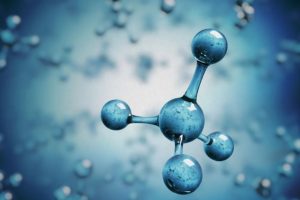
A $1 million grant from the U.S. Department of Energy (DOE) is supporting a Johns Hopkins chemical and biomolecular engineer’s efforts to create a catalyst that will break ammonia down into hydrogen and nitrogen—a step in the move towards clean energy technology.
The grant, awarded to a team led by Chao Wang, associate professor in the Whiting School of Engineering’s Department of Chemical and Biomolecular Engineering, is part of the DOE’s initiative to accelerate research, development, and demonstration of affordable clean hydrogen technologies. Wang’s project, which also includes Hopkins colleague Yannis Kevrekidis and researchers at the University of Maryland College Park and Purdue University, will support efforts to advance the development of clean hydrogen and enable the widespread commercial adoption of the energy source.
“Our goal is to develop novel alloy catalysts that can break down ammonia more efficiently than current catalysts,” said Wang. “The technology we are working on could substantially reduce the energy costs of taking hydrogen from ammonia, setting the stage for using liquid ammonia as a hydrogen carrier for a variety of energy applications.”
Wang explains that ammonia (NH3) is a great hydrogen carrier due to its high energy density and ease of liquification, making it easier to transport and handle. By decomposing NH3, hydrogen can be removed and be used for fuel in various applications, from powering cars to generating electricity in fuel cells.
Catalysts are commonly used to extract hydrogen from the NH3 bond. Previously, catalysts used the metal ruthenium in this process, but its scarcity and cost make it impractical for large applications. Instead, researchers have focused on the use of alloy catalysts: those comprising two or more elements. Previous studies have found that those made of cobalt and molybdenum were effective in breaking apart hydrogen and nitrogen in NH3, but the two must be used in a specific ratio to work well together. In addition, studies show that this catalyst works best with small amounts of NH3, not allowing for large quantities of hydrogen to be extracted.
To combat these issues, Wang and his team propose to develop advanced high-entropy alloy (HEA) catalysts for efficient ammonia (NH3) decomposition. HEAs are alloys that are commonly formed by mixing equal parts of five or more elements. By tweaking the ratio of metals, they aim to create catalysts that remain stable as they break down NH3. HEAs have “high configural entropy,” meaning their atoms can be arranged in multiple configurations. This high configural entropy is believed to be the key towards optimizing the surface properties needed for efficient NH3 decomposition.
The team also plans to develop a reactor with multiple layers of catalysts to match the change in NH3 levels, allowing for better decomposition.
“Our goal is to precisely tune the catalyst compositions so we can convert more than 99% of the ammonia in a single pass through the reactor at temperatures below 500 degrees Celsius,” said Wang.
Wang says that the use of HEA catalysts offers many advantages over traditional catalysts, including improved performance and durability. He says the team’s approach to convert more than 99% of the NH3 through the reactor will make the process cost-effective and more energy efficient. Manufacturing of the catalyst will also be faster, he says, allowing for wider use and even breakthrough into other energy and chemical sectors.
“The catalysts and reactor will improve the efficiency of NH3 decomposition, reducing the cost and energy consumption. This will enable the use of liquid ammonia as a hydrogen carrier. We hope to see this implementation make liquidized NH3 an easy and effective way to transport hydrogen for energy,” said Wang.
In addition to Wang and Kevrekidis, the team includes Liangbing Hu at the University of Maryland College Park and Jeffrey Greeley, at Purdue University.